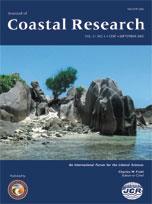Algal blooms, often associated with eutrophication, are common in temperate regions in coastal lagoons and estuarine areas as well as in open seas. However, because of recent changes in water flows and sediment and nutrient loads in most rivers, eutrophication phenomena are now occurring in areas previously non affected. One of its most widespread and easily recognized effects in a coastal marine ecosystem is the excessive growths and drifts of macroalgae, to such a degree that the biomass becomes a significant problem.
The nutrients, notably from anthropogenic origin, constitute a significant factor in the appearance of the blooms in coastal waters. Besides a background originating from natural areas and precipitations, nutrients come from agriculture, sewage, industry, and aquaculture, in very various proportions following the local conditions.
At first, the development of opportunist and tolerant seaweeds acts as a purifying system. Then, when the seaweed is stranded or the environmental conditions become unfavourable, the plants die and decompose. The degradation of the chemical equilibrium induces the break-down of the biological balance in the ecosystem. At this stage, a large biomass can become troublesome, resulting in an increase in the herbivore population, competition or toxicity towards flora and fauna, alteration of the sediment, recycling of nutrients and pollutants in the ecosystem, nuisance for local residents and reduction of tourism (beaches degradation, chironomids, odors). Sooner or later, the water deteriorates, which may have a toxic effect on fauna including the commercial fish stocks.
Eutrophication problems have thus become a matter of major concern. Its management is neither a simple nor a cheap task. But, environmental and sustainability concerns may, in a not too distant future, override the lack of financial benefit. At any rate, underlayed action is required because in estuarine and potamologic milieus, potential land disposal arrangements are becoming rarer and costlier.
Control of eutrophication can only be reached effectively by drastic reduction of the total nutrient load of an overloaded water system. In order to be successful, only an integrated approach, based on a water body's nutrient mass balance and taking into consideration specific geographical, climatological and ecological conditions, can be effective. Moreover, it may take many years before recovery of a eutrophicated ecosystem, because the sediments constitute a complementary source of nutrients for macroalgae. But, prevention will prevent the nutrients from being discharged in the lagoons or in the sea. It will concern the waste treatment, agricultural mode change and treatment of gaseous effluent from polluting human activities.





